microRNA-877 contributes to decreased non-small cell lung cancer cell growth via the PI3K/AKT pathway by targeting tartrate resistant acid phosphatase 5 activity
- PMID: 33222607
- PMCID: PMC7751652
- DOI: 10.1080/15384101.2020.1839697
microRNA-877 contributes to decreased non-small cell lung cancer cell growth via the PI3K/AKT pathway by targeting tartrate resistant acid phosphatase 5 activity
Abstract
Non-small cell lung cancer (NSCLC) is a leading cause of cancer death in both men and women. microRNAs (miRs) can exert important functions in cancer development. However, the role of miR-877 in NSCLC as it relates to tartrate resistant acid phosphatase 5 (ACP5) is unknown. For this study, the gain-and-loss-of-function experiments were performed to explore the effects of miR-877 and ACP5 on NSCLC. miR-877 expression in LC and paracancerous tissues, lung epithelial cell line and NSCLC cell lines was detected, and the association between miR-877 expression and clinical features of LC patients was analyzed. The levels of ACP5, epithelial-mesenchymal transition (EMT) markers and apoptosis-related proteins were measured. In vivo experiments were conducted for further validation. Consequently, we found that miR-877 expression was lowered in LC tissues and cell lines, and correlated with clinical stage, differentiation, lymph node metastasis and prognosis of NSCLC patients. Additionally, miR-877 was determined to inhibit ACP5 activity, and miR-877 downregulated the PI3K/AKT pathway by silencing ACP5. Furthermore, overexpression of miR-877 inhibited the viability, migration, invasion and EMT of NSCLC cells, but promoted cell apoptosis. In conclusion, miR-877 overexpression inhibited malignant biological behaviors of NSCLC cells by downregulating ACP5 and inactivating the PI3K/AKT pathway.
Keywords: Non-small cell lung cancer; PI3K/AKT pathway; microRNA-877; tartrate resistant acid phosphatase 5.
Conflict of interest statement
The authors declare no conflicts of interest.
Figures
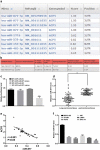
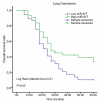
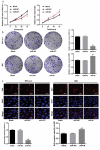
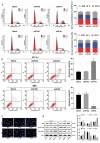

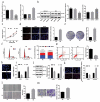


Similar articles
-
MicroRNA-92a promotes epithelial-mesenchymal transition through activation of PTEN/PI3K/AKT signaling pathway in non-small cell lung cancer metastasis.Int J Oncol. 2017 Jul;51(1):235-244. doi: 10.3892/ijo.2017.3999. Epub 2017 May 16. Int J Oncol. 2017. PMID: 28534966
-
MiR-101-3p inhibits the growth and metastasis of non-small cell lung cancer through blocking PI3K/AKT signal pathway by targeting MALAT-1.Biomed Pharmacother. 2017 Sep;93:1065-1073. doi: 10.1016/j.biopha.2017.07.005. Epub 2017 Jul 18. Biomed Pharmacother. 2017. PMID: 28738500
-
Effect of microRNA-135a on Cell Proliferation, Migration, Invasion, Apoptosis and Tumor Angiogenesis Through the IGF-1/PI3K/Akt Signaling Pathway in Non-Small Cell Lung Cancer.Cell Physiol Biochem. 2017;42(4):1431-1446. doi: 10.1159/000479207. Epub 2017 Jul 17. Cell Physiol Biochem. 2017. PMID: 28715819
-
The tumor suppressor role and ceRNA network of miR-1294 in cancer.Oncol Res. 2023 Mar 1;31(1):1-12. doi: 10.32604/or.2022.027359. eCollection 2023. Oncol Res. 2023. PMID: 37303740 Free PMC article. Review.
-
MicroRNA155 in non-small cell lung cancer: a potential therapeutic target.Front Oncol. 2025 Feb 3;15:1517995. doi: 10.3389/fonc.2025.1517995. eCollection 2025. Front Oncol. 2025. PMID: 39963112 Free PMC article. Review.
Cited by
-
Circulating cell-free and extracellular vesicles-derived microRNA as prognostic biomarkers in patients with early-stage NSCLC: results from RESTING study.J Exp Clin Cancer Res. 2024 Aug 22;43(1):241. doi: 10.1186/s13046-024-03156-y. J Exp Clin Cancer Res. 2024. PMID: 39169404 Free PMC article.
-
Silencing of lncRNA CRNDE attenuates nonsmall-cell lung cancer progression by mediating the miR-455-3p/HDAC2 axis.Kaohsiung J Med Sci. 2022 Aug;38(8):749-760. doi: 10.1002/kjm2.12558. Epub 2022 May 25. Kaohsiung J Med Sci. 2022. PMID: 35611803 Free PMC article.
-
Prediction of lung overdistension during mechanical ventilation using micro-RNA and gene expression.Intensive Care Med Exp. 2025 Jun 7;13(1):60. doi: 10.1186/s40635-025-00768-2. Intensive Care Med Exp. 2025. PMID: 40481913 Free PMC article.
-
A Comprehensive Study on Signal Transduction and Therapeutic Role of miR-877 in Human Cancers.Adv Biomed Res. 2023 May 15;12:118. doi: 10.4103/abr.abr_412_21. eCollection 2023. Adv Biomed Res. 2023. PMID: 37434921 Free PMC article. Review.
-
Splice and Dice: Intronic microRNAs, Splicing and Cancer.Biomedicines. 2021 Sep 19;9(9):1268. doi: 10.3390/biomedicines9091268. Biomedicines. 2021. PMID: 34572454 Free PMC article. Review.
References
-
- Mulherkar R, Grewal AS, Berman AT.. Emerging role of immunotherapy in locally advanced non-small cell lung cancer. Clin Adv Hematol Oncol. 2020;18(4):212–217. - PubMed
-
- Reck M, Popat S, Reinmuth N, et al. Metastatic non-small-cell lung cancer (NSCLC): ESMO clinical practice guidelines for diagnosis, treatment and follow-up. Ann Oncol. 2014;25(Suppl 3):iii27–39. . - PubMed
-
- Fajersztajn L, Veras M, Barrozo LV, et al. Air pollution: a potentially modifiable risk factor for lung cancer. Nat Rev Cancer. 2013;13(9):674–678. . - PubMed
MeSH terms
Substances
LinkOut - more resources
Full Text Sources
